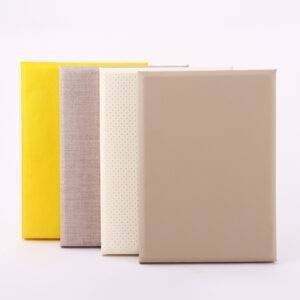To be honest, all materials have the ability to absorb some amount of sound energy. Sound-absorbing materials, on the other hand, will absorb much of the sound energy that strikes them and reflects very little. These specialized materials are commonly referred to as “acoustical materials,” and they are intended to have high absorption qualities. They are useful in noise control within a space or enclosure because of these characteristics.
Sound Absorbing Material Types
Acoustic absorption is the dissipation and transformation of sound energy into another form of energy, such as heat, mechanical energy, or deformation.
There are three types of sound absorbers, according to science: membrane, porous, and resonance.
A variety of sound-absorbing materials are available. Their ability to absorb sound waves is heavily influenced by composition, mounting method, thickness, and frequency.
Membrane/Plate Absorbers
A membrane, also known as a plate absorber, is a non-porous, non-rigid material, that is placed over airspace. The absorber takes in sound energy when it is applied to it, and the oscillating system (front panel mass and trapped air spring) transforms into mechanical energy.
These materials have a solid appearance and are particularly effective against low-frequency sounds such as higher frequency sounds and bass.
Common examples of membrane absorbers are hardboard paneling, windows, suspended plaster ceilings, wood, wood floors, and doors.
Porous Absorbers
Porous materials have a high sound absorption coefficient, are permeable and not dense.
Soundwaves penetrate these materials’ surfaces and flow into the cellular or fibrous structure that they contain. Only a small quota of the sound energy is reflected back into the space when porous sound absorbers are used.
Porous sound absorbers work best for treble tones or mid-range. They have less of an effect on lower frequencies and have no effect on bass.
Common examples of porous sound absorbers include carpets, insulation blankets, certain forms of foam plastic, mineral wool, and fiberboards.
Resonate/Resonance Absorbers
These sorts of sound absorbers are often utilized only when a certain frequency range must be combated. They are used to concentrate on difficulties concerning bass frequencies.
These absorbers operate on the basis of sound pressure. It’s really just a mass vibrating against a spring. You can change the resonance frequency by adjusting either the mass or the stiffness of the spring.
Layers of perforated plasterboard or metal corrugated sheets are examples of resonance absorbers.
Acoustic Absorber Materials
The following are examples of practical uses of the topics discussed above.
– Pillows and cushions
They are known as porous sound absorbers. Their porous substance and soft surfaces can absorb soundwaves and convert them to heat energy. The denser they are, the more sound they can absorb.
– Decorations for the walls
Paintings, fabric or linen tapestries, and huge photographs can help to minimize reverberations caused by passing through walls.
– Area Rugs and Carpets
Carpets and area rugs can assist in absorbing impact sounds and preventing sound transmission through structures.
– Blankets and curtains
Soundproofing windows is best accomplished by replacing them with laminated glass or windows with two or three panes.
– Window Film with Acoustics
Glass is thin, extremely conductive, and very reflective, making it a poor sound barrier. Acoustic
– Acoustic Dividers
An acoustic divider built of sturdy structural materials is another product that may be used to absorb sound. While they don’t do much to filter out sound, they do a fantastic job of absorbing it.
– Panels of Acoustic Foam
The panels are formed of a soft, porous substance with notches or cups for sound absorption. Soundwaves will be absorbed rather than reflected off walls, doors, or ceilings if you hang them on doors, walls, or ceilings.
Professional Acoustics Solution Provided
We have been in the acoustic industry for 12 years. Our team is always ready to answer your questions and provide professional advice. Contact us today at dayin@dayinacoustics.com.



